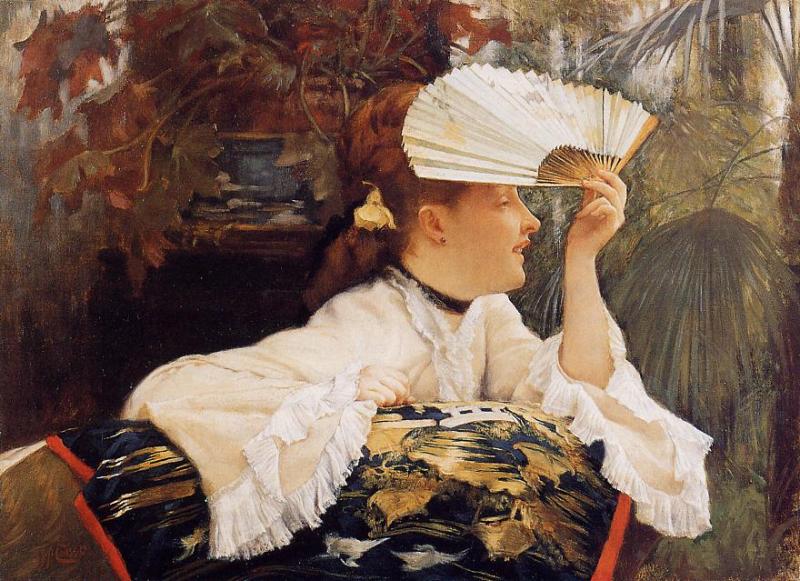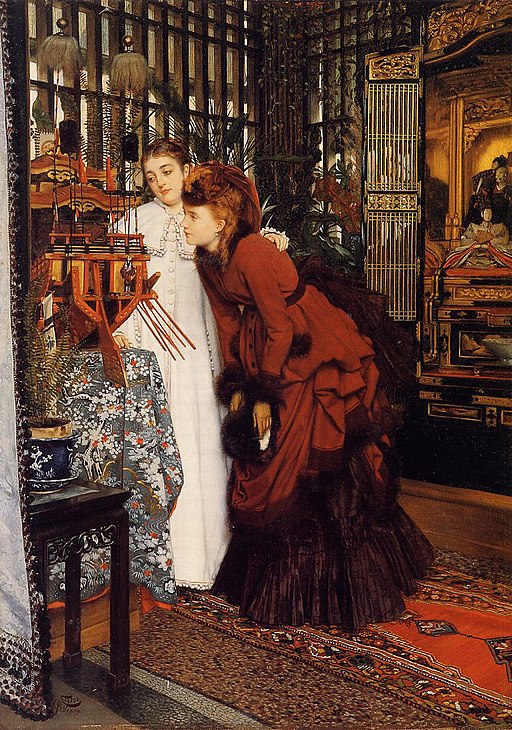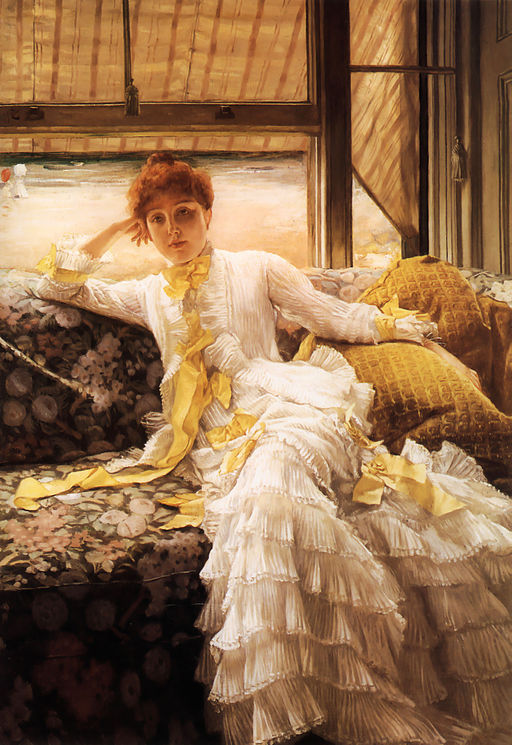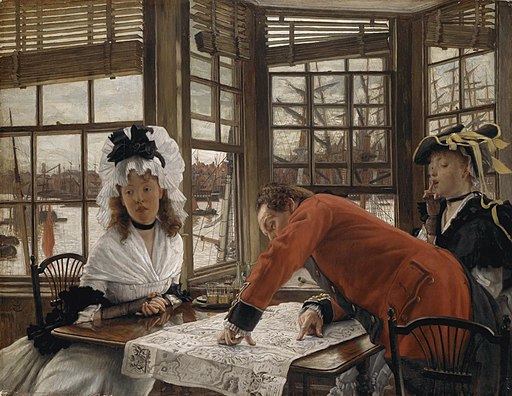
“The Gallery of HMS Calcutta” by James Tissot
James Tissot became famous as a painter of fashionably dressed women. Below is our Virtual Exhibition of “Flirtation and Attraction in Art” by James Tissot:
- “The Gallery of HMS Calcutta” by James Tissot – Tate Britain
- “Portsmouth Dockyard” by James Tissot – Tate Britain
- “October” by James Tissot – Montreal Museum of Fine Arts
- “The Fan” by James Tissot – Wadsworth Atheneum Museum of Art
- “Without a Dowry” by James Tissot – Private collection
- “The Ball” by James Tissot – Musée d’Orsay
- “Young Ladies Looking at Japanese Objects” by James Tissot – Cincinnati Art Museum
- “Seaside” by James Tissot – Cleveland Museum of Art
- “The Bridesmaid” by James Tissot – Leeds Art Gallery
- “A Woman of Ambition” by James Tissot – Albright–Knox Art Gallery
- “An Interesting Story” by James Tissot – National Gallery of Victoria, Australia
- “Bad News” by James Tissot – National Museum Cardiff
- “Portrait of Marquise de Miramon” by James Tissot – Getty Center
- “Still on Top” by James Tissot – Auckland Art Gallery Toi o Tāmaki
- “Embarkation in Calais” by James Tissot – Royal Museum of Fine Arts Antwerp
- “The Captain’s Daughter” by James Tissot – Southampton City Art Gallery
- “Portrait of Miss Lloyd” by James Tissot – Tate Britain
- “Two Sisters” by James Tissot – Musée d’Orsay
“The Gallery of HMS Calcutta” by James Tissot
“The Gallery of HMS Calcutta (Portsmouth)” by James Tissot depicts a man with two women. All three subjects are used by the artist to explore the subtlety of flirtation and attraction through body language and facial expression.
In this painting, the chaperone separates the young naval lieutenant from the woman hiding her enjoyment of his flirtation behind her fan. Tissot explores the boundaries of Victorian propriety and social conventions. Tissot’s portrayal of the young woman’s fashionable hour-glass figure led to criticism of this depiction when it was first exhibited.
Each woman is wearing a fashionable gauzy white dress decorated with bows and ribbons, with a tightly fitting bodice over a corset and full skirts below the hips. The hourglass figures echo the curves of the gallery’s railings.
The painting is set on the quarter gallery at the stern of the Royal Navy warship HMS Calcutta.
The Gallery of HMS Calcutta (Portsmouth)
- Title: The Gallery of HMS Calcutta (Portsmouth)
- Alternative: Officer and Ladies on Board HMS Calcutta
- Artist: James Tissot
- Year: 1876
- Medium: Oil on canvas
- Dimensions Height: 68.6 cm (27 ″); Width: 91.8 cm (36.1 ″)
- Museum: Tate Britain
~~~
“Portsmouth Dockyard” by James Tissot

“Portsmouth Dockyard” by James Tissot
“Portsmouth Dockyard” by James Tissot depicts three people sitting in a rowing boat. In the center is a man wearing the uniform of a sergeant in a Highland Regiment, with redcoat, kilt, and feather bonnet. He sits with his legs crossed, and his hands clasped around one bare knee. He is turning away from his sullen-looking companion, and towards the smiling woman to his right.
The painting’s story is about a man trying to choose between two women. Based on the body language and facial cues, he appears to have made his choice.
In the background of this scene, among the towering naval vessels in Portsmouth Dockyard, is another rowing boat crewed by maritime personnel passing in the background before the bows of two old-fashioned square-rigged ships of the line. Further in the background is a modern ironclad warship.
A similar painting by Tissot shocked audiences when it was shown at the Royal Academy in 1876 because of the questionable sexual morals of its characters. One critic described it disparagingly as “more French than English.” This painting has a similar theme.
Portsmouth Dockyard
- Title: Portsmouth Dockyard
- Alternative: How Happy I Could Be with Either
- Français: Entre Les Deux Mon Coeur balance
- Artist: James Tissot
- Year: 1877
- Medium: Oil on canvas
- Dimensions Height: 54.6 cm (21.4 ″); Width: 38.1 cm (15 ″)
- Museum: Tate Britain
~~~
“October” by James Tissot

“October” by James Tissot
“October” by James Tissot depicts the artist’s Irish lover Kathleen Newton who was twenty-two years old and the mother of two children when Tissot met her. From 1876 Tissot lived with her, a divorced woman, which violated the moral standards in Victorian England. Kathleen Newton became Tissot’s muse and preferred model.
Tissot referred to his years with Newton as the happiest of his life. Unfortunately, she died in 1882, and five days after her death, Tissot moved back to Paris.
October
- Title: October
- Artist: James Tissot
- Year: 1894
- Medium: Oil on canvas
- Dimensions 216 × 108.7 cm (85 × 42.8 in)
- Museum: Montreal Museum of Fine Arts
~~~
“The Fan” by James Tissot

“The Fan” by James Tissot
“The Fan” by James Tissot was painted about 1875 in London, where he had been living after the Franco-Prussian War and the Paris Commune. He lived in a comfortable home at St. John’s Wood, where he built an extension with a studio and conservatory. In his new conservatory, Tissot painted some of his “Flirtation and Attraction” images, including “The Fan,” which celebrates his continuing fascination with Japonisme during this era.
A woman wearing a loose, pale yellow dressing gown leans against an embroidered silk draped over the back of an armchair as she fans herself. Her dress is trimmed in pleated ruffles, and she wears the black ribbon around her neck. A yellow flower dangles from her coiled braids, echoing the motifs in the embroidered silk.
The Fan
- Title: The Fan
- Artist: James Tissot
- Year: 1875
- Medium: Oil on canvas
- Dimensions 15 1/8 x 20 1/2 in
- Museum: Wadsworth Atheneum Museum of Art
~~~
“Without a Dowry” by James Tissot

“Without a Dowry” by James Tissot
“Without a Dowry” by James Tissot is one in a series called La Femme à Paris and is also known as “Sunday in the Luxembourg Garden.” The Jardin de Luxembourg is a large garden playground known for its lawns, tree-lined promenades, and flowerbeds, which was a popular recreational area on the Left Bank.
At the time of this painting, the chair rental is probably the only Sunday pleasure these two women could afford. The mother and the daughter are in mourning and without a sufficient dowry, the young woman had little hope for a prosperous marriage proposal. At the time, marriage was a serious business in France, and money was essential for attracting appropriate partners.
Without a Dowry – Sunday in the Luxembourg Gardens
- Title: Without a Dowry (also known as Sunday in the Luxembourg Gardens)
- Artist: James Tissot
- Year: 1883 – 1885
- Medium: Oil on canvas
- Museum: Private collection
~~~
“The Ball” by James Tissot

“The Ball” by James Tissot
“The Ball” by James Tissot depicts a young woman wearing a lavish yellow dress, arriving at a society event. The femininity of the woman is emphasized through the interplay of curves. Her spread out fan is in the center of the painting and echoes the curve of her shoulders. Her long train is decorated with interlaced ribbons and lace revealed by the armchair with Japanese influenced motifs of fish in the water.
The fish in the water symbolizes the scene she is about to entre. The young woman will slip effortlessly into this social circle where her beauty will attract attention. Her companion is seen only from behind, and he features the white hair of age. Concealed in this way, the man’s role is reduced to no more than opening the doors to high society for his partner. The young woman is already taking the lead from him, as she looks into the distance.
In the background, some of the women are eyeing the new arrival to determine the potential influence or challenge from the latest guest to enter the ballroom scene.
The Ball
- Title: The Ball or Evening
- Artist: James Tissot
- Year: 1878
- Medium: Oil on canvas
- Dimensions Height: 90 cm (35.4 ″); Width: 50 cm (19.6 ″)
- Museum: Musée d’Orsay
~~~
“Young Ladies Looking at Japanese Objects” by James Tissot

“Young Ladies Looking at Japanese Objects” by James Tissot
“Young Ladies Looking at Japanese Objects” by James Tissot
Young Ladies Looking at Japanese Objects
- Title: Young Ladies Looking at Japanese Objects
- Français: Entre les deux mon coeur balance
- Artist: James Tissot
- Year: 1869
- Medium: Oil on canvas
- Dimensions Height: 70.5 cm (27.7 ″); Width: 50.2 cm (19.7 ″)
- Museum: Cincinnati Art Museum
~~~
“Seaside” by James Tissot

“Seaside” by James Tissot
“Seaside” by James Tissot
Seaside
- Title: Seaside
- Artist: James Tissot
- Year: 1878
- Medium: Oil on canvas
- Dimensions Height: 87.5 cm (34.4 ″); Width: 61 cm (24 ″)
- Museum: Cleveland Museum of Art
~~~
“The Bridesmaid” by James Tissot

“The Bridesmaid” by James Tissot
“The Bridesmaid” by James Tissot
The Bridesmaid
- Title: The Bridesmaid
- Artist: James Tissot
- Year: 1885
- Medium: Oil on canvas
- Dimensions 147.3 x 101.6 cm
- Museum: Leeds Art Gallery
~~~
“A Woman of Ambition” by James Tissot

“A Woman of Ambition” by James Tissot
“A Woman of Ambition” by James Tissot
A Woman of Ambition
- Title: A Woman of Ambition or The Reception or Political Woman
- Artist: James Tissot
- Year: 1885
- Medium: Oil on canvas
- Dimensions Height: 142.2 cm (56 ″); Width: 101.6 cm (40 ″)
- Museum: Albright–Knox Art Gallery
~~~
“An Interesting Story” by James Tissot

“An Interesting Story” by James Tissot
“An Interesting Story” by James Tissot depicts two fashionably dressed young being bored by a sailor who is engrossed in his own storytelling. Exhibited at the Royal Academy in 1872, this was one of the first paintings Tissot showed in London after he left France at the fall of the Paris Commune in 1871. Tissot soon found success in London painting fashion with humour and irony.
The setting of this painting on the Thames would have made it appealing to contemporary audiences during a time when many artists were exploring the historic, romantic and nostalgic qualities of the Thames.
An Interesting Story
- Title: An Interesting Story
- Artist: James Tissot
- Year: 1872
- Medium: oil on wood panel
- Dimensions: Height: 59.7 cm (23.5″); Width: 76.6 cm (30.1″)
- Museum: National Gallery of Victoria, Australia
~~~
“Bad News” by James Tissot

“Bad News” by James Tissot
“Bad News” by James Tissot
A Woman of Ambition
- Title: Bad News or The Parting
- Artist: James Tissot
- Year: 1872
- Medium: Oil on canvas
- Dimensions Height: 68.6 cm (27″); Width: 91.4 cm (35.9″)
- Museum: National Museum Cardiff
~~~
“Portrait of Marquise de Miramon” by James Tissot

“Portrait of Marquise de Miramon” by James Tissot
“Portrait of Marquise de Miramon” by James Tissot depicts the Marquise wearing a rose-colored, ruffled peignoir. Around her neck are a black lace scarf and a silver cross. Behind her is a fashionable Japanese screen depicting cranes on a gold background, and on the mantelpiece are several Japanese ceramics. The Louis XVI stool and the terracotta bust suggests her aristocratic status. This painting was exhibited at the Paris World Fair.
Thérèse Feuillant (1836 – 1912) inherited a fortune from her father and in 1860 she married Réné de Cassagne de Beaufort, Marquis de Miramon.
Portrait of Marquise de Miramon
- Title: Portrait of Marquise de Miramon, née, Thérèse Feuillant
- Artist: James Tissot
- Year: 1866
- Medium: Oil on canvas
- Dimensions Height: 1,283 mm (50.51″); Width: 772 mm (30.39″)
- Museum: Getty Center
~~~
“Still on Top” by James Tissot

“Still on Top” by James Tissot
“Still on Top” by James Tissot has a photographic quality and depicts two women assist an elderly servant wearing a red cap, to raise a line of flags. The painting’s title may refer to the British Union Jack, which is obscured at the top.
James Tissot had a reputation for parody and wit, the title of the painting would reflect his irony.
Still on Top
- Title: Still on Top
- Artist: James Tissot
- Year: 1873
- Medium: Oil on canvas
- Dimensions Height: 876 mm (34.48″); Width: 533 mm (20.98″)
- Museum: Auckland Art Gallery Toi o Tāmaki
~~~
“Embarkation in Calais” by James Tissot

“Embarkation in Calais” by James Tissot
“Embarkation in Calais” by James Tissot
Embarkation in Calais
- Title: Embarkation in Calais
- Artist: James Tissot
- Year: 1878-1882
- Medium: Oil on canvas
- Dimensions 140,5 × 97,5 cm; 146,5 × 102 × 1,7 cm
- Museum: Royal Museum of Fine Arts Antwerp
~~~
“The Captain’s Daughter” by James Tissot

“The Captain’s Daughter” by James Tissot
“The Captain’s Daughter” by James Tissot
The Captain’s Daughter
- Title: The Captain’s Daughter
- Artist: James Tissot
- Year: 1873
- Medium: Oil on canvas
- Museum: Southampton City Art Gallery
~~~
“Portrait of Miss Lloyd” by James Tissot

“Portrait of Miss Lloyd” by James Tissot
“Portrait of Miss Lloyd” by James Tissot
Portrait of Miss Lloyd
- Title: The Captain’s Daughter
- Artist: James Tissot
- Year: 1876
- Medium: Oil on canvas
- Dimensions: Height: 91.4 cm (35.9″); Width: 50.8 cm (20″)
- Museum: Tate Britain
~~~
“Two Sisters” by James Tissot

“Two Sisters” by James Tissot
“Two Sisters” by James Tissot
Two Sisters
- Title: Two Sisters
- Artist: James Tissot
- Year: 1863
- Medium: Oil on canvas
- Dimensions: Height: 210 cm (82.6″); Width: 136 cm (53.5″)
- Museum: Musée d’Orsay
James Tissot
Jacques Joseph Tissot (1836 – 1902), anglicized as James Tissot, was a French painter and illustrator. He was a successful painter in Paris before moving to London in 1871. He became famous as a genre painter of fashionably dressed women.
Tissot left Paris after the Franco-Prussian War and resided in London from 1871. He knew James McNeill Whistler and Edgar Degas, but turned away from Impressionism and focused mainly on portraits and genre paintings of the Victorian upper classes in a more polished academic style. These pictures are typical of Tissot’s work, depicting his subjects with almost photographic realism. He composed ambiguous narratives that hinted at risqué behavior among the wealthy classes and the boundaries of propriety.
Late in his career, Tissot had a revival of his Catholic faith, which led him to spend the last fifteen years of his life painting Biblical events. At a time when French artists were working in impressionism, pointillism, and heavy oil washes, Tissot was moving toward realism in his watercolors.
To assist in his completion of biblical illustrations, Tissot traveled to the Middle East in the late 1880s to make studies of the landscape and people.
James Tissot
- Name: Jacques Joseph Tissot
- Born: 1836, Nantes, France
- Died: 1902 (aged 65), Chenecey-Buillon, France
- Nationality: French
- Notable works:
- The Art of Fashion, Flirtation and Attraction by James Tissot
- “The Gallery of HMS Calcutta” by James Tissot – Tate Britain
- “Portsmouth Dockyard” by James Tissot – Tate Britain
- “October” by James Tissot – Montreal Museum of Fine Arts
- “The Fan” by James Tissot – Wadsworth Atheneum Museum of Art
- “Without a Dowry” by James Tissot – Private collection
- “The Ball” by James Tissot – Musée d’Orsay
- “Young Ladies Looking at Japanese Objects” by James Tissot – Cincinnati Art Museum
- “Seaside” by James Tissot – Cleveland Museum of Art
- “The Bridesmaid” by James Tissot – Leeds Art Gallery
- “A Woman of Ambition” by James Tissot – Albright–Knox Art Gallery
- “An Interesting Story” by James Tissot – National Gallery of Victoria, Australia
- The Life of Christ by James Tissot
- Crucifixion, seen from the Cross
- Jesus Found in the Temple
- Jesus Wept
- Bible Illustrations by James Tissot
- The Art of Fashion, Flirtation and Attraction by James Tissot
French Artists you should Know
-
-
- Georges de La Tour (1593 – 1652)
- Nicolas Poussin (1594 – 1665)
- Élisabeth Sophie Chéron (1648 – 1711)
- François Boucher (1703 – 1770)
- Jean-Honoré Fragonard (1732 – 1806)
- Jacques-Louis David (1748 – 1825)
- Jean-Auguste-Dominique Ingres (1780 – 1867)
- Eugène Delacroix (1798 – 1863)
- Rosa Bonheur (1822 – 1899)
- Jean-Léon Gérôme (1824 – 1904)
- Camille Pissarro (1830 – 1903 )
- Édouard Manet (1832 – 1883)
- Edgar Degas (1834 – 1917)
- James Tissot (1836 – 1902)
- Paul Cézanne (1839 – 1906)
- Auguste Rodin (1840 – 1917)
- Claude Monet (1840 – 1926)
- Pierre-Auguste Renoir (1841 – 1919)
- Berthe Morisot (1841 – 1895)
- Henri Rousseau (1844 – 1910)
- Gustave Caillebotte (1848 – 1894)
- Paul Gauguin (1848 – 1903)
- Jean Béraud (1849 – 1935)
- Georges Seurat (1859 – 1891)
- Henri de Toulouse-Lautrec (1864 – 1901)
- Pierre Bonnard (1867 – 1947)
- Artists and their Art
- Famous French Artist You Should Know
-
~~~
“There is something of the human soul in his work, and that is why he is great, immense, infinite.”
– Vincent van Gogh on James Tissot
~~~
Photo Credit: 1) James Tissot [Public domain]; James Tissot [CC BY-SA 4.0 (https://creativecommons.org/licenses/by-sa/4.0)]
Popular this Week








 Sponsor your Favorite Page
Sponsor your Favorite Page SEARCH Search for: Search Follow UsJoin – The JOM Membership Program
Sponsor a Masterpiece with YOUR NAME CHOICE for $5
Share this:
- Tweet
